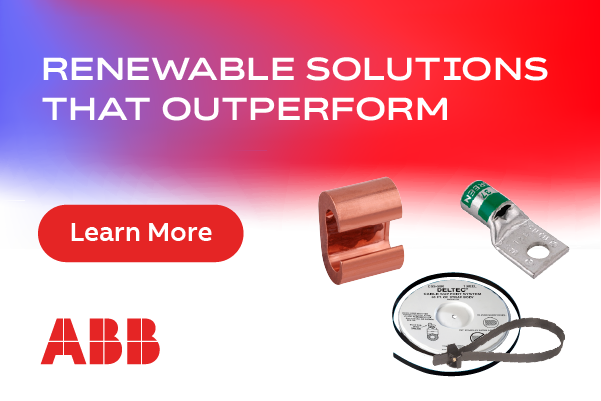Slip Ring Installations Made Safer
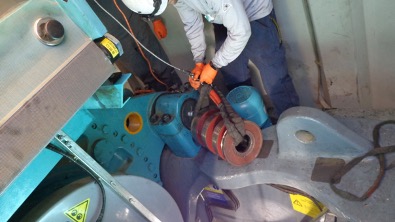 Safely handling heavy slip rings at the top of a wind turbine can be a difficult task for even the most highly skilled technicians. Slip rings or collector rings have become heavier to handle more current from larger MW turbines. Many are now also made from bronze, which is expensive, softer than steel, and more easily damaged. A common method of handling involves using a simple sling inserted through the center of the collector rings. This method leaves many risks to both the technicians and the valuable slip ring. As with any task, a properly engineered solution can make a difference in protecting people from injury - and expensive collector rings from damage.
Safely handling heavy slip rings at the top of a wind turbine can be a difficult task for even the most highly skilled technicians. Slip rings or collector rings have become heavier to handle more current from larger MW turbines. Many are now also made from bronze, which is expensive, softer than steel, and more easily damaged. A common method of handling involves using a simple sling inserted through the center of the collector rings. This method leaves many risks to both the technicians and the valuable slip ring. As with any task, a properly engineered solution can make a difference in protecting people from injury - and expensive collector rings from damage.
Our industry cannot afford for personnel to suffer injuries, especially ones that can be easily prevented. A collector ring with even the slightest dent can bounce the brushes off the surface, causing arcing that will quickly destroy the slip ring (yet another unnecessary and unacceptable cost that the industry can ill afford).
The task of handling slip rings begins at the O&M building and continues all the way through until the collector ring is safely installed on the generator. Once the job is complete, the focus shifts to safely handling the used collector ring as it is removed and transported back to the O&M building for recycling or repair.
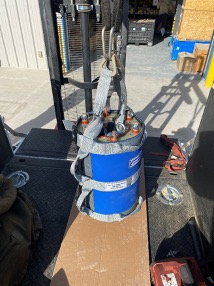 The first task that presents risk is lifting the heavy slip ring as it is loaded into the truck to take it to the turbine. Utilizing the shop forklift and a wrap to contain the collector ring is a safe method to move it from the shop to the truck (right). A wrap designed with lifting straps that go through the center of the collector rings protects them. It also makes it easier for technicians during additional guiding or handling, as well as after the heavy slip ring assembly is loaded into the truck.
The first task that presents risk is lifting the heavy slip ring as it is loaded into the truck to take it to the turbine. Utilizing the shop forklift and a wrap to contain the collector ring is a safe method to move it from the shop to the truck (right). A wrap designed with lifting straps that go through the center of the collector rings protects them. It also makes it easier for technicians during additional guiding or handling, as well as after the heavy slip ring assembly is loaded into the truck.
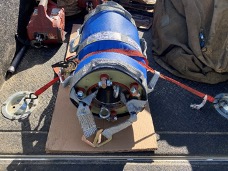 The next step is safely and securely transporting the heavy slip ring from the O&M building to the turbine. During transport, the collector ring is secured with a ratchet strap that passes through the handles of the wrap (left). This is a simple and secure method that not only prevents the collector ring from rolling around and becoming damaged during transport, but also helps prevent the slip ring from launching into the cab if a vehicle accident or other major incident were to happen.
The next step is safely and securely transporting the heavy slip ring from the O&M building to the turbine. During transport, the collector ring is secured with a ratchet strap that passes through the handles of the wrap (left). This is a simple and secure method that not only prevents the collector ring from rolling around and becoming damaged during transport, but also helps prevent the slip ring from launching into the cab if a vehicle accident or other major incident were to happen.
Moving the heavy slip ring from the back of the truck into the turbine can be a significant safety challenge using common conventional methods. 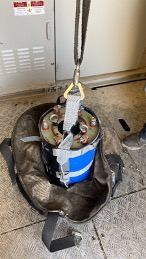 A much safer method is transferring the collector ring from the truck into the tower utilizing a two man lift and the tower hoist for assistance into the tower, protecting the slip ring investment and, most importantly, the workers (right). The design of the handles on the slip ring wrap can greatly assist in the safety of this difficult task - lifting straps through the center of the slip ring give a secure place to pull with the chain hoist. The tower hoist can then be used to insert the protected slip ring into the lift bag for final and safe hoisting to the yaw deck, along with other tools and supplies for the job. The wrap protects the slip ring from damage by any other equipment in the lift bag.
A much safer method is transferring the collector ring from the truck into the tower utilizing a two man lift and the tower hoist for assistance into the tower, protecting the slip ring investment and, most importantly, the workers (right). The design of the handles on the slip ring wrap can greatly assist in the safety of this difficult task - lifting straps through the center of the slip ring give a secure place to pull with the chain hoist. The tower hoist can then be used to insert the protected slip ring into the lift bag for final and safe hoisting to the yaw deck, along with other tools and supplies for the job. The wrap protects the slip ring from damage by any other equipment in the lift bag.
The next step, moving the collector ring from yaw deck to Nacelle, involves connecting a pullzall to the lifting straps. This provides a safe and protective means to safely guide the slip ring past obstacles during the lift, while the wrap shields the expensive collector ring from damage. Tag lines can easily be attached to handles keeping technicians in safe locations during the transition from yaw deck to nacelle (below).
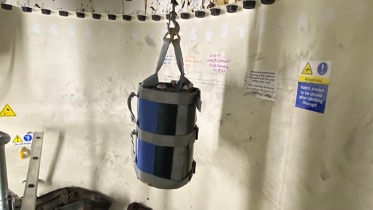
The final task of maneuvering the heavy slip ring assembly in the nacelle is often done with a technician on each end of the sling inserted through the center. A properly engineered wrap makes this task much safer. Many injuries occur because technicians are trying to protect the rings and they end up straining muscles during the sacrifice. A thick rubber protective wrap eliminates this mindset. It also protects the expensive slip ring so technicians are less reluctant to set it down quickly if they have an immediate need to prevent a muscle strain.
The next time your technicians need to handle collector rings, the safe and smart approach would be to seek an engineered solution specifically designed to prevent injuries and protect your most valuable assets - your people.
George Finley is Manager at Morgan Advance Materials, which specializes in designing and manufacturing high performance products and systems for industrial, power generation, rail, and wind turbine markets. In addition to slip rings assemblies, Morgan also offers an engineered Slip Ring Safety Wrap.
Morgan Advanced Materials | www.morganelectricalmaterials.com
Author: George FinleyÂ
Volume: 2022 January/February








